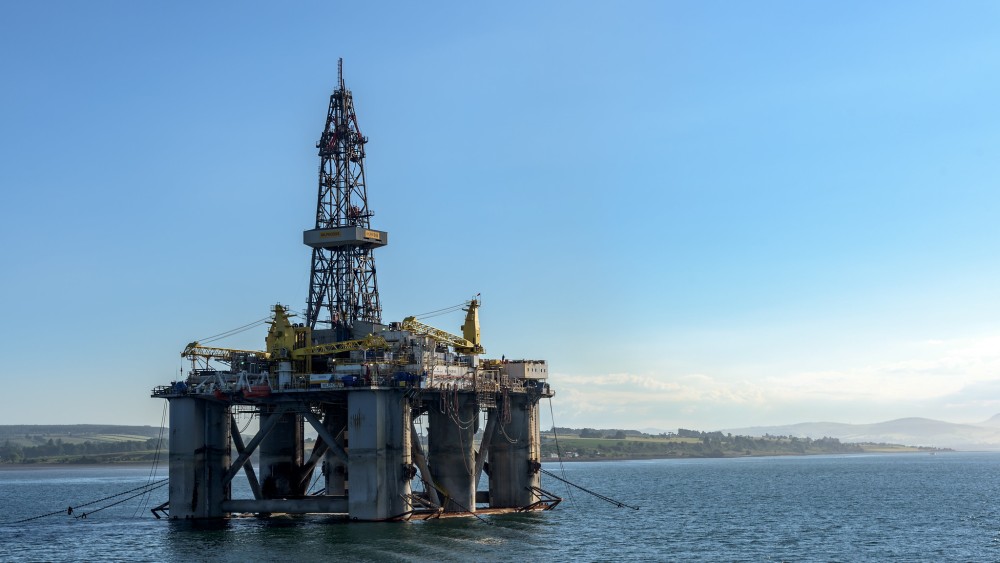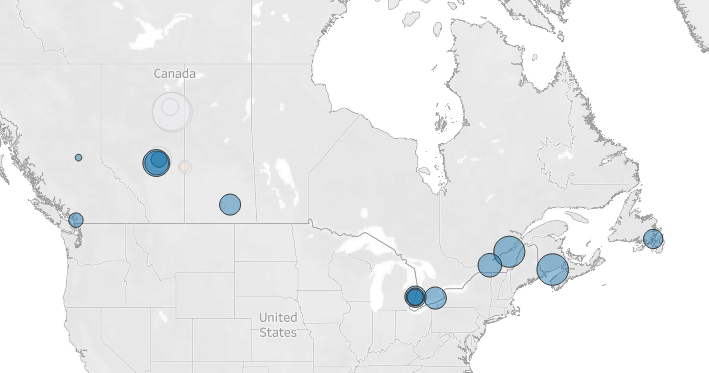
An offshore oil rig. This is the kind of oil extraction that happens off the coast of Newfloundland, in the Hibernia oil field.
Photo by Joe deSousa
Crude awakening
The Green Party of Canada has released its climate action plan for the fall election. It's called Mission: Possible, and lays out a path to zero carbon emissions, renewable energy, and green jobs all in a spirit of political co-operation.
If we're going to turn the corner on the climate crisis, it's our responsibility to work across party lines, and for our ambition to meet the scale of the challenges we face.
Part of that plan includes weaning our country off fossil fuels. The Green plan includes putting a stop to imported oil, and refining our own petroleum products as we transition to renewables.
It's important to understand that this has nothing to do with the conservative "ethical oil" argument. Fossil fuels are a sunset industry. We don't advocate expanding oil extraction in Canada. No new wells, no additional output, no new pipelines. Canada already produces more oil than we consume, so let's use our resources wisely.
But what does that transition look like? Can we turn off the taps to imported oil, and meet the needs of Eastern Canada without any new pipelines?
(This post focuses on oil specifically. Natural gas is a whole other kettle of fish, and we need to reduce our dependence on that, too!)
1. Production
First things first: how much crude oil does Canada actually extract from the ground?
Crude oil production by province, 2018 (source)
| Province | Barrels per day (thousands) |
|---|---|
| BC | 100 |
| AB | 3,700 |
| SK | 480 |
| MB | 40 |
| ON | 0.5 |
| QC | — |
| NB | — |
| NS | 0.7 |
| PE | — |
| NL | 230 |
| YT | — |
| NT | 1 |
| NU | — |
| Total | 4,552 |
Every day, Canada is extracting 4.5 million barrels of oil from the ground. This mostly comes from Alberta's oil sands, as well as conventional drilling in BC, Saskatchewan, and Newfoundland.
2. Refining
Before we can use it for fuel, crude oil needs to be refined into gasoline, propane, diesel, or whatever the end product will be. The amount of crude oil that gets refined each day is called the daily crude runs.
Canada actually refines quite a bit of petroleum products! Not all of it comes from Canadian sources, though. Often, we export raw crude to the USA or other countries, and import different types of crude oil that our refineries can more easily handle.
While our major oil deposits are located in remote areas — northern Alberta and off the coast of Newfoundland — refineries are typically closer to major population centres.

Refinery activity by region, 2018
| Region | Daily crude runs (source) Barrels per day (thousands) | Daily capacity (source) Barrels per day (thousands) |
|---|---|---|
| Western | 560 | 690 |
| Ontario | 370 | 390 |
| Québec & Eastern | 680 | 780 |
| Total | 1,610 | 1,860 |
So, what have we learned so far? Canada extracts 4.5 million barrels of oil, and refines about 1.6 million barrels into finished fuel products every day. (If our refineries were operating at full capacity, that would be 1.8 million barrels per day.)
Stay with me here, we still need some more data to round out the picture.
3. Consumption/demand
According to the National Energy Board, Canada's total demand in 2017 for refined petroleum products was 1.8 million barrels per day.
Interesting! That's the same amount of oil that our refineries are capable of producing.
I wonder what that consumption looks like when you break it down by region.
Demand for refined petroleum products by region
| Region | Demand, 2017 source Barrels per day (thousands) |
Refinery capacity, 2018 source Barrels per day (thousands) |
|---|---|---|
| Western | 739 | 690 |
| Ontario | 562 | 390 |
| Québec & Eastern | 528 | 780 |
| Total | 1,828 | 1,860 |
Western Canada consumes 49,000 barrels per day more than it refines. Ontario consumes 172,000 barrels per day more than it refines. And Québec & Eastern Canada has a bit of a surplus, refining 252,000 barrels more than it consumes.
On average, a “representative tank” of Canadian gasoline consists of 70% gasoline refined in the province where it is consumed, 20% gasoline refined in another province, and 10% imported gasoline.
— National Energy Board
Despite population increases, Canada's demand for petroleum has stayed pretty much flat for the last decade. Our cars, homes, and industrial processes are getting more efficient, but we're using more of them. A report from the National Energy Board, Canada’s Energy Future 2018, shows us that a business-as-usual scenario has us continuing to use about the same amount of petroleum products each year, all the way to 2040. The biggest culprits are transportation and industrial uses.
4. Imports and exports
We import 760,000 barrels of oil per day, of which 42% comes from the USA. When the Green Party talks about cutting off oil imports, which provinces will be affected most?
| Region | Crude oil imports, 2016 source Barrels per day (thousands) |
Crude oil exports, 2018 source Barrels per day (thousands) |
|---|---|---|
| Western | 150 | 3,300 |
| Ontario | 90 | 0 |
| Québec & Eastern | 520 | 300 |
| Total | 760 | 3,600 |
The way forward
Alright. Now we know how much oil we produce, refine, consume, import, and export. These are the levers we have to play with if we're going to transition to a clean economy and cut off oil imports.
The first and most obvious course of action is to scale down operations in the Alberta oil sands. Western Canada and Ontario only need 1.3 million barrels of oil per day, so let's set oil sands production limits at that level immediately. We can handle that demand with existing pipeline infrastructure, though we may need to increase refinery capacity in Western Canada.
As we make our way toward a zero-carbon economy, oil sands workers can be put to work building wind, solar, and run-of-river hydroelectric plants. These are zero-emission energy solutions that don't disrupt ecosystems and can be located closer to communities where the energy is needed.
These kinds of energy projects are also smaller-scale, which means local communities can have more control and ownership over energy projects taking place in their own backyards. We don't need nuclear power or mega-dams to save us from the clutches of fossil fuels.
Beyond the electricity grid, we also need an aggressive push to electrify industrial processes and our transportation networks. Personal cars, transit vehicles, and commercial fleets can all be replaced by electric vehicles. Wouldn't it have been better for our government to spend $9.3 billion on those kinds of adaptations, than to buy a leaky old pipeline?
Looking at Québec and Eastern Canada, we'll have to do a bit more up-front work on reducing demand before we can cut off all oil imports. As that happens, Newfoundland's oil production will be able to meet the needs of those 5 provinces.
In all areas of the country, East and West, we'll have to retrofit existing refineries to handle domestic crude oil.
We don't need to build any new pipelines to make this transition happen. We don't even need to keep oil sands production at current levels. We can cut it in half almost immediately. By using our existing oil infrastructure, reducing demand, building new electricity capacity, and upgrading refineries, it's definitely possible to phase out our dependence on oil as we build a better, greener, cleaner society.
Sam Nabi